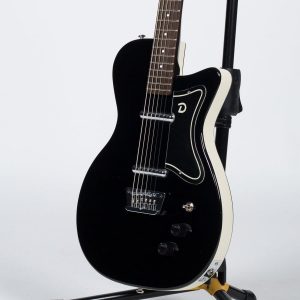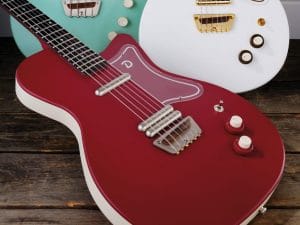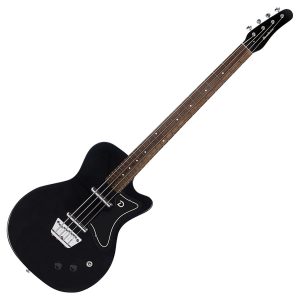Features
Table of Contents
The recently revamped Danelectro guitar range now includes four variations of this brand’s first reissue, with one boasting a lot more bling than ever before. Review by Roger Cooper
Danelectro in 2011 is a mixture of the crazy and the mainstream. The nutty side is represented by the new Wild Thing, and we’ll have a review coming up in G&B before you can say the words ‘Crikey, that could do you a nasty injury.’ The more sensible side comes from a new array of single-cuts, including an authentic imitation of the U2 six-string from the ’50s, plus three variations on this same theme. One of which is up for inspection this month.

The ’56 Single Cutaways all share the same body shape and construction but differ in terms of finish, pickup configuration and headstocks. The headstock is one area where this month’s review star stands out. Because unlike Danelectro classic ‘coke bottle’ design or the asymmetric ‘dolphin nose’ shape the white and gold ’56 is topped by an oversized peghead known as the ‘Full Bell’. First seen on early Danos in the mid-1950s. The title is descriptive, as the broad, tapering outline is very obviously bell-like. The equally period-correct face carries a full-length gold scroll that brackets an angled Danelectro logo.
The tuners aren’t as historically accurate, being metal button-equipped copies of the familiar vintage Kluson design. But they don’t look out of place and work well enough. Like all other metalwork on this ’56 model, the machine heads are gold. And this plating is echoed by the similarly coloured scratchplate and headstock detailing.
Danelectro 56 Single Cutaway Design
The Midas touch extends to the screw-fixed aluminium nut, a familiar Dano twist that the company seems reluctant to lose. It’s far from the most friction-free material. But the headstock’s gentle back-angle and shallow sideways string splay help keep snagging to a minimum.
Measurements of the maple neck are more modern than vintage, and it has a very playable broad C profile. The 21 medium-gauge frets are well-finished, and while the rosewood fingerboard adopts a 14″ radius that’s actually curvier than the virtually flat original. The 635mm/25″ scale length stays true to Dano tradition.
The neck is firmly secured by no fewer than five screws and sits in a neck pocket that’s narrower in width. So the neck heel is chamfered to match. The obvious intention is to reduce mass and improve upper end access. But the upper strap button rather gets in the way.

In the ’50s Danelectro economy-conscious body construction consisted of a simple pine frame, faced front and back with hardboard. These days the semi-solid centre section is plywood. And the 3kg/6.6lbs weight is well balanced and back-friendly. The sides are decorated with embossed vinyl tape. The only cream colour on this otherwise white guitar – while the scratchplate is transparent.
Style
The two lipstick-style single-coils have alnico magnets, and height adjustments are made via screws sited on the body back. The controls also represent another return to old Dano design, with a clunky metal three-way toggle selector partnered by a pair of dual-concentric pots. These are topped with contrasting colour two-tier plastic knobs. The small top sections control tone, while the wider diameter lower levels regulate volume.
At the bridge, the metal saddles seen on many modern Danos have been replaced by the single wooden type favoured in the ’50s. This can be slid or swivelled slightly to provide some intonation adjustment. But range is limited and results are obviously a compromise, although our review example plays commendably in tune. The strings are secured in notches along the back edge; twin front support screws govern height, while a third anchors the rear and alters backward tilt. The design does leave string end windings exposed, and these can sometimes prove quite painfully sharp under the palm.

Danelectro 56 Single Cutaway Sounds
The semi-solid construction gives the ’56 Single Cutaway a generous amount of resonance to accompany its mid-toppy. Almost Dobro-like acoustic tonality. Amplified it’s bright but not brash, and the wooden bridge saddle must be helping to aurally even things out. The neck pickup blends a snaky treble with some nasal low end. While the bridge single-coil is equally open but leaner, janglier and edgier. The centre pickup selector notch is the ’56’s strongest sonic suit. This engages both pickups in series, boosting output and injecting some musical muscle while cutting down on noise.
Gain-induced dirt takes chords from clangy to crunchy. While lead lines acquire a gnarly grit that’s tailor-made for bluesy noodling, retro rock or lo-fi solo work. The guitar will accommodate more overdrive. But heaping too much on reduces tonal focus and note definition and can give rise to squeals at higher levels. The volume controls have a versatile gradual taper. But the tone pots prove to be sudden-death in terms of their transition from full treble to woolly warmth.
Verdict
The presence of gold-plating seems somewhat at odds with the Dano brand’s essentially low-budget ethosю But the end result actually makes a quite attractive alternative to this ’56 Single Cutaway’s more soberly-attired stablemates. The cosmetics may be different. But although that headstock is an eye-opener. It’s nice to know that it’s a real – if obscure – vintage Dano feature. Playability and performance attributes match its partners. Which means this inexpensive electric offers great value and equally copious quantities of character. It should appeal to players of all ages, abilities and bank accounts, deservedly keeping the Danelectro flag flying high.

Leave a Reply
You must be logged in to post a comment.